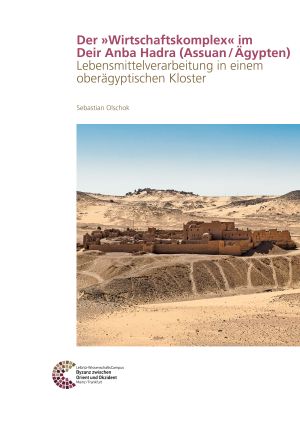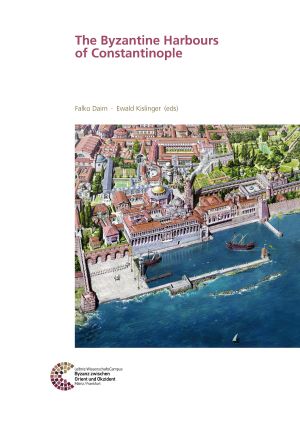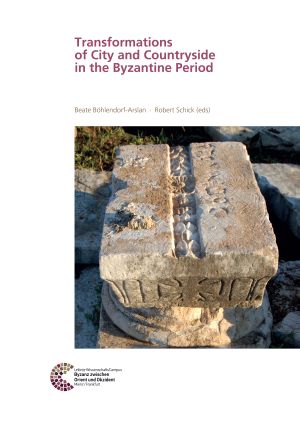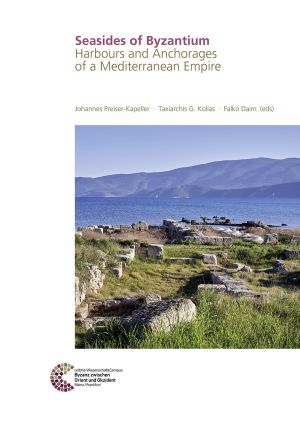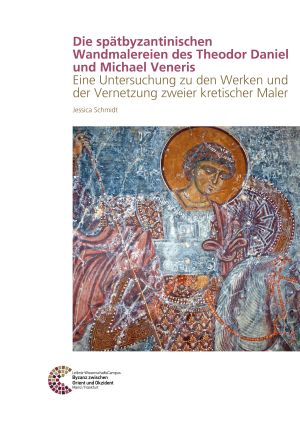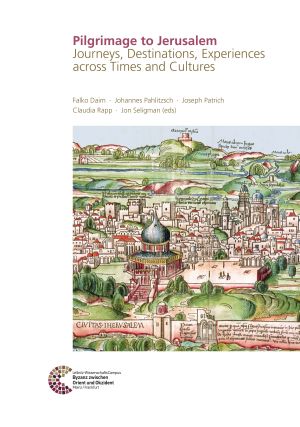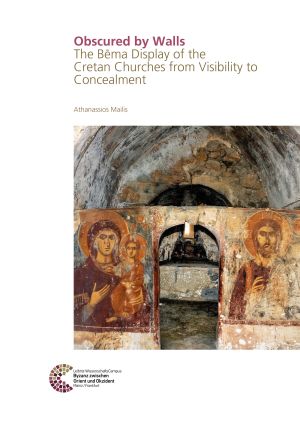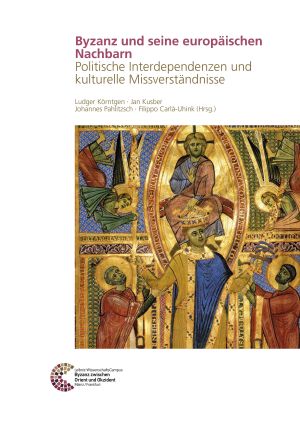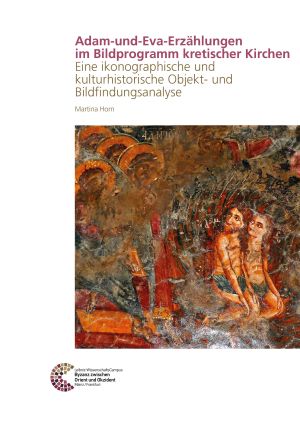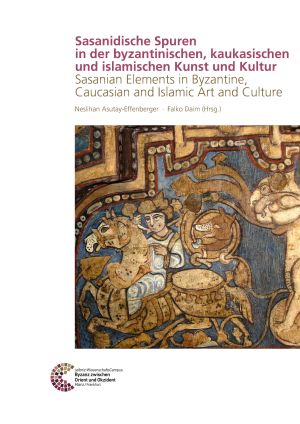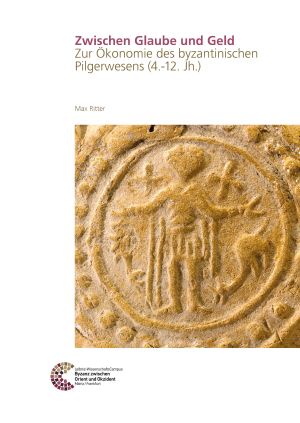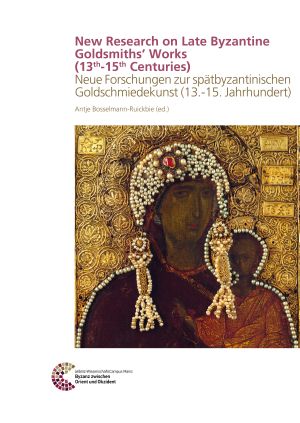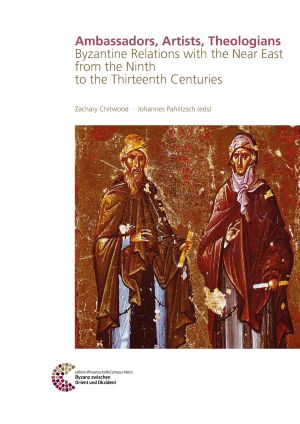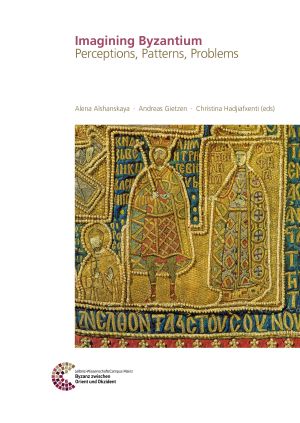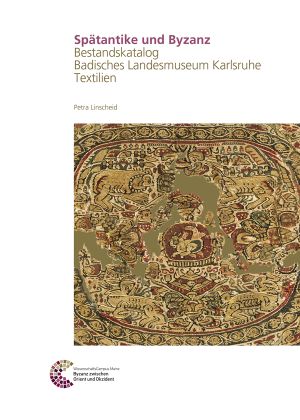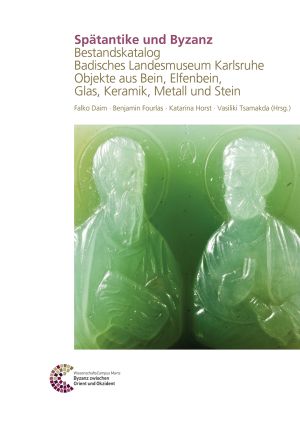Byzanz zwischen Orient und Okzident
Der ScienceCampus – Byzantium between Orient and Occident – Mainz / Frankfurt is a joint research venture between the Leibniz-Zentrum für Archäologie, the Johannes Gutenberg University Mainz, der Goethe-University Frankfurt and the Leibniz Institute of European History. The aim is to institutionally establish a broad platform for interdisciplinary Byzantium research. Participating are beside Byzantine studies, Christian archaeology and Byzantine art history, all subjects that make a contribution to the research of the Byzantine Empire and its culture. The ScienceCampus Mainz / Frankfurt promotes the integration of the fragmented scientific disciplines that deal with Byzantium. It enables theme-oriented, multidisciplinary, historic-cultural research consolidated under one umbrella and improves the visibility of the subject area through a joint appearance of Byzantine research.
The series “Byzantium between Orient and Occident” serves as publication organ for the research programme of the Leibniz ScienceCampus Mainz/Frankfurt that studies Byzantium, its role as bridge between East and West, and cultural transfer and reception processes from Antiquity to modern times. The methods and research subjects of the various disciplines dedicated to Byzantium are brought together across traditional disciplinary boundaries in order to take a comprehensive historical and cultural approach to research into Byzantium and its material and immaterial culture.

Contact
Leibniz-WissenschaftsCampus – Byzanz zwischen Orient und Okzident – Mainz/Frankfurt
Dr. Benjamin Fourlas
Leibniz-Zentrum für Archäologie
Ludwig-Lindenschmit-Forum 1
D-55116 Mainz
E-Mail: fourlas@rgzm.de
Internet: Homepage
Published so far
Einheit in der Vielfalt? Zur Kulturpflanzennutzung imByzantinischenReich unter besondererBerücksichtigung archäobotanischerUntersuchungen in Caričin Grad(Justiniana Prima)
Plants are of great importance in everyday human life, serving not only as sources of food, but also as a source of raw materials, building materials, fuel or feed for domestic animals. Different plant spectra can therefore provide insights into people's everyday lives, their cultural preferences or environmental conditions. The study deals with crop use in the Byzantine Empire based on archaeobotanical data and has two main foci: on the one hand, the archaeobotanical analysis of macroremains from the early Byzantine city of Caričin Grad in southern Serbia, on the basis of which the diet of the urban population as well as agricultural practices are reconstructed. On the other hand, a literature-based supra-regional and diachronic overview of crop use in the Byzantine Empire (395-1453) is given. In the evaluation at the regional level, characteristic features of crop use of each region and the respective epochs are elaborated against the historical background and the prevailing environmental conditions and then transferred into a supra-regional and diachronic overview.
Das byzantinische Erbe der Serben: Byzantinische Argumente und Narrative in der serbischen Nationalbewegung (1780-1868)
This study examines the significance of the Byzantine Orthodox heritage for the national movement of the Serbs in the 18th and 19th centuries. Based on contemporary historiographical works, newspaper articles, correspondence and laws, the monograph is dedicated to the use of the offer of surviving structures of the Byzantine Empire and its Church by Serbian nation-builders: The focus of the study is on ecclesiastical and secular actors from the narrow stratum of the Serbian educated and functional elite, who accessed and dealt with the Byzantine legacy to stage and legitimise rule, to consolidate their own identity and to justify certain political strategies.
Der »Wirtschaftskomplex« im Deir Anba Hadra (Assuan / Ägypten): Lebensmittelverarbeitung in einem oberägyptischen Kloster
The Coptic monastery of Deir Anba Hadra is located opposite the southern Egyptian city of Aswan on the west bank of the Nile. This largest and best-preserved monastery in the region has been researched since 2013 by an interdisciplinary project within the framework of a DAI concession. The “economic complex” on the upper terrace was investigated in terms of construction history and archaeology as part of this project. In the evaluation, 16 construction phases were identified, which can be associated with different functions, and it is possible to identify this building complex as a site for food production. Bread, castor oil, wine and garum were produced here.
The building history research has shown that the core of the complex was originally built as an oratory for the monks´ hourly prayers. With the addition of several functional rooms, it was extensively redesigned after the 6th/7th century. This transformation made it possible to set up a bakery, the capacities of which were gradually expanded. With the construction of a crushing basin castor oil could be produced in the northern part of the building complex. Further north, a wine press was added, and two tanks were built in the immediate vicinity of the press. They were probably used to produce garum. In addition to the deliberate dismantling of individual walls, fireplaces and feeding troughs are evidence of the use of various walls even after the end of the use of Deir Anba Hadra as a monastery.
The production facilities identified at Deir Anba Hadra were compared with installations in the (late) ancient Mediterranean. Through these comparisons, not only technical details can be explained, but also production processes.
Negotiating Power and Identities: Latin, Greek and Syrian Élites in Fifteenth-Century Cyprus
This study traces the development of Latin, Greek and Oriental Christian aristocratic groups and their interaction in fifteenth-century Cyprus. Since 1192, the island was under the rule of the Lusignan Crusader dynasty, which had introduced a nobility of Crusader families. However, due to various moments of political crisis from the end of the fourteenth century on, autochthonous Greeks and Oriental Christians (so-called Syrians) rose high in the state administration and challenged the power balance. This study explores their social mobility as well as the fate of the noble Crusaders who had to contend with the newcomers, and the consequences for the relationship between these groups. Moreover, it asks how the aristocrats constructed their identities with respect to social standing, ethnicity and religion. This analysis of the interplay between social change and identity construction permits a new, broad perspective on the Cypriot aristocracies during the fifteenth century.
The Byzantine Harbours of Constantinople
The fortunes of Byzantine Constantinople have always been inextricably linked to the sea. The topographical, demographic and economic development of the city and its networks are reflected in the history of its harbours. This volume offers an exhaustive study of Constantinople’s Byzantine harbours on the Sea of Marmara and the Golden Horn, as well as nearby European and Asian landing stages. The fifteen chapters by eleven contributors here present a broad synthesis of the current state of research using written, pictorial and archaeological sources.
Veränderungen von Stadtbild und urbaner Lebenswelt in spätantiker und frühbyzantinischer Zeit: Assos im Spiegel städtischer Zentren Westkleinasiens
The transformation and restructuring of the ancient city in Asia Minor in the Late Antique and Early Byzantine periods has become a central topic of archaeological and historical research in recent decades. The contributions to this volume present an extremely differentiated picture of the development of cities and their surrounding areas during this period. An ideal starting point for this is the city of Assos on the southern coast of the Troad, where the transformation of the ancient city from the 4th to the 8th century has been the focus of research since 2013. The picture gained there is placed in a broader context in the present volume by contributions on Pergamon, Sardis, Ephesos, Didyma and Sagalassos, which shed light on the development process of the Late Antique and Early Byzantine cities of Western Asia Minor in very different ways from various aspects.
Transformations of City and Countryside in the Byzantine Period
The concept of »transformation« or simply »reshaping« contains the elements of what remains, the conservative, the kernel of what continues, as well as the elements of what changes, the innovative. In the framework of this publication of articles from a conference in 2016 on »Transformations of City and Countryside in the Byzantine Period«, we draw attention to this dichotomy and investigate the social dynamics behind changes in urban and rural life in the Byzantine period that can be detected by archaeology, history and art history.
The Byzantine Empire is an ideal subject for studying how social transformation proceeds, what triggers transformation, what factors underlie it and what the processes involved are. Who were the agents of transformation and how did they and their environment change? How flexible were the state or its citizens in handling external and internal pressures of innovation? In what manner and to what extent were the Byzantines able to preserve their identity and the internal cohesion of their empire in the course of these processes of adaptation?
Seasides of Byzantium: Harbours and Anchorages of a Mediterranean Empire
In recent years, interest in the study of maritime installations and networks in the Roman and Byzantine Mediterranean has increased considerably, as documented by various projects and publications.
The conference »Seasides of Byzantium. Harbours and Anchorages of a Mediterranean Empire«, from which the papers collected in the present volume emerged, took place in Athens in 2017 as part of a cooperation between the DFG-funded Special Research Programme (SPP 1630) »Harbours from the Roman Period to the Middle Ages« and the National Hellenic Research Foundation. It united historians, archaeologists and geoarchaeologists to explore harbours and anchorages as core maritime infrastructure to the Late Roman and Byzantine Empire.
General phenomena such as the organisation of the Byzantine navy and its operations or lighthouses are discussed in this volume as well as new geoarchaeological research methodologies in harbour archaeology. Most contributions in the present volume examine case studies for the most important maritime core region of the Byzantine Empire, the Aegean. This sea connected the remaining provinces of the empire in Southeastern Europe and Asia Minor after the loss of Syria, Palestine, Egypt, and North Africa to the Arabs in the 7th century AD. In addition to technical and geographical aspect, the studies in this volume make clear that we need to explore more and more the social embedding of the seasides of Byzantium to understand their dynamics in all their complexity.
Die spätbyzantinischen Wandmalereien des Theodor Daniel und Michael Veneris: Eine Untersuchung zu den Werken und der Vernetzung zweier kretischer Maler
For late Byzantine art history, Crete provides a unique collection of monuments. The period from 1211 to 1669, when the island was under the rule of the Venetians, allows insights into a multifaceted and complex society. Within this unique artistic and cultural landscape, the works of the late Byzantine church painter Theodor Daniel and his nephew Michael Veneris particularly stand out. The present publication devotes itself for the first time to an in-depth and wide-ranging investigation of their works. Beside the identification and attribution of their unsigned works, analyses accruing from this form key aspects. The most important step for the aims expressed is provided by the systematic attribution of the pair’s works. This and the assignment of the unsigned works are found in the first part of the publication. In the second part the interconnections of Theodor Daniel and Michael Veneris with other Cretan artists is discussed. Beside contacts with Ioannes Pagomenos, probably the most prominent Cretan church painter of the 14th century, there is a further series of indications that suggest that there existed a regular network among the artists on the island.
Pilgrimage to Jerusalem. Journeys, Destinations, Experiences across Times and Cultures: Proceedings of the Conference held in Jerusalem, 5th to 7th December 2017
Jerusalem is a city holy to three world religions: Judaism, Christianity and Islam. From the early Byzantine period, Christian pilgrimage here and to other holy sites became a »mass phenomenon«. Thousands of Christians set out to holy sites in Palestine, Egypt and other places in order to physically experience salvation history and seek divine intervention in their lives. Numerous travel reports, pilgrim guides and other written sources highlight important aspects of pilgrimage. In addition, many well-preserved churches, monasteries, hostels and other buildings, as well as rich archaeological findings, provide us with a vivid and synthetic picture of the history of pilgrimage to the Holy Land.
Obscured by Walls: The Bēma Display of the Cretan Churches from Visibility to Concealment
The book researches the Bēma display of the Cretan churches in a time period spanning from the Byzantine re-conquest of the island (11th century) until the middle of the Venetian dominance (15th century). It focuses on the apparition and distribution of the Templon-barrier, the function of a certain group of frescoes as prostration images and the (partial) establishment of fresco-painted masonry screens at the Orthodox churches of the island, just before the prevalence of the »wooden wall of icons« – known as Iconostasis.
This study reveals the artistic and cultic multiplicity of arrangements, consisting of archaism and modernization, until the crystallization of the Iconostasis as the »distinctive feature of churches of the Byzantine rite«, thus a material proof of cultural identity and religious consciousness of the Orthodox populace in an area (Crete) and a period (Venetian rule) that is characterized by both osmosis and conflict.
Byzanz und seine europäischen Nachbarn: Politische Interdependenzen und kulturelle Missverständnisse
On the one hand cultural misunderstandings represent a prerequisite for intercultural communications, on the other hand they can also be understood as a method or result of interculturalism and transcultural relationships. In this process there are unthinking as well as provoked and politically manipulated misunderstandings, or rather alleged misunderstandings, which disguise real political or church political conflicts of interest. In addition, there are misunderstandings in research which sometimes states a misunderstanding too quickly, where logic and context are not immediately evident. Such misunderstandings dictated the political-cultural pattern of relationships among the Byzantine Empire, the Latinised West and Slavic world, who all regarded themselves as parts of ecumenical Christianity and who stood in close political and cultural contact over many centuries. In the present book proponents of history, Byzantine studies, art history and theology apply themselves to the analysis of this phenomenon.
Adam-und-Eva-Erzählungen im Bildprogramm kretischer Kirchen: Eine ikonographische und kulturhistorische Objekt- und Bildfindungsanalyse
The Western sacred art landscape of the Middle Ages presents a rich pageantry of images about the Adam and Eve story by using overlapping genres. In the large-scale paintings of the Eastern Church, on the other hand, the subject is only included in the repertoire of the churches during the post-Byzantine period. Thus, the innovative origins of Adam and Eve cycles in Venetian Crete of the 14th and 15th centuries, are even more remarkable. In five of the numerous painted Cretan churches, pictorial sequences with Adam and Eve were integrated into the iconographic concept. Beside the reconstruction of the partially destroyed frescoes, the comprehensive process of the iconographic invention will be subject of a detailed examination in this study, based on art- and cultural-historical analysis. The genesis of the wall paintings is characterized by a strong tension and a dynamic interplay between the preservation of traditional and available patterns and the inventiveness of innovative and creative elements. The broadly diversified research including Western and Eastern art traditions offers not only surprising insights into unusual pictorial formulas, but also in the varying reasons of reception in relation to the donors and their specific motivation.
Sasanidische Spuren in der byzantinischen, kaukasischen und islamischen Kunst und Kultur: Sasanian Elements in Byzantine, Caucasian and Islamic Art and Culture
The empire of the Persian Sassanids (AD 224-651) extended over the area of modern-day Iran, Iraq, Azerbaijan, Pakistan and Afghanistan. Even the Caucasus regions lay under their political influence. Many elements of Sassanian art and culture can be found in neighbouring lands, such as the Byzantine Empire and Christian Caucasus, and, following the fall of the Sassanids, continued in those areas under Islamic control which had developed on their former territory.
In order to investigate the continuing role of the Sassanian Persians and their culture, in September 2017 an international conference was held in the Römisch-Germanisches Zentralmuseum in Mainz. The papers given by academics from various disciplines are published in the present volume.
Zwischen Glaube und Geld: Zur Ökonomie des byzantinischen Pilgerwesens (4.-12. Jh.)
Piety is not the sole impulse for the development of Christian pilgrimage. From a wide chronological and regional perspective, the book deals with the economic connections which influenced the essence of Byzantine pilgrimages (5th – 12th c.).
To pilgrimage is always religiously motivated and socially imbedded, yet the detailed choice of the pilgrim’s destination, the route, the gifts of thanks at the end and many other aspects were and are determined by basic economic constants and time-dependent, social-economic dynamics.
The book highlights Byzantine pilgrims’ shrines, analyses their origins but also their structure of organisation and finance, which had already been legally framed during Late Antiquity.
New Research on Late Byzantine Goldsmiths’ Works (13th-15th Centuries): Neue Forschungen zur spätbyzantinischen Goldschmiedekunst (13.-15. Jahrhundert)
This volume comprises 13 papers from the conference »New Research on Late Byzantine Goldsmiths‘ Works (13th-15th Centuries)«, held at the Römisch-Germanisches Zentralmuseum in Mainz in October 2015. The contributions primarily deal with the material culture of goldsmiths’ works, such as crosses, reliquary caskets, jewellery, enamel works, and precious stones, spanning the wide geographical area of Byzantium and many of its neighbours, from Russia via Trebizond and Serbia to Crete. Furthermore, written sources on Byzantine goldsmiths, their craft and the provenance of precious metals provide evidence for goldsmithing in Byzantium throughout its history.
Ambassadors, Artists, Theologians: Byzantine Relations with the Near East from the Ninth to the Thirteenth Centuries
The contributors in the edited volume »Ambassadors, Artists, Theologians: Byzantine Relations with the Near East from the Ninth to the Thirteenth Centuries« examine the complex dynamics which arose between the Byzantine Empire and the Near East. Moving beyond the tradition of histoire événementielle, the contributions collected here highlight the passing of artistic practices, ideas and interlocutors between Byzantium and the Islamicate world. In this way, this volume seeks to nuance and contextualize our understanding of the relationship between these two medieval cultural spheres.
Imagining Byzantium: Perceptions, Patterns, Problems
Byzantium the other. Byzantium the pompous. Byzantium the eternal. The mere existence of this empire with his rich history and otherness from western European traditions spurred the minds of scholars, noblemen, politicians and ordinary people throughout its survival and long beyond its final downfall in 1453. Neglecting its great political and cultural influence on neighbouring countries and beyond, Enlightenment writers stripped Byzantium of its original historical reality and thus created a model, which could be utilised in very different constructs, stretching from positive to absolutely negative connotations. With the rise of new nationalisms, primarily in Eastern and Southeastern Europe, and the associated politically inspired historical (re)constructions in the 19th and 20th century, the reception of Byzantium gained new facets, its perception reached into new dimensions. In this volume, we would like to shed some light on these patterns and the problems they entail, and show the different ways in which »Byzantium« was used as an argument in nation-building and in constructing new historiographical narratives, and how its legacy endured in ecclesiastical historiography.
Für Seelenheil und Lebensglück: Das byzantinische Pilgerwesen und seine Wurzeln
The final international conference of the project "For Salvation and Happiness: Byzantine Pilgrimage and its Roots", held in December 2015, gathered scholars from the disciplines of archaeology, Byzantine studies, art history, historical sciences, religious history, epigraphy and historical geography, who addressed the phenomenon of pilgrimage in the Byzantine Empire. The contributions consider the connections of Byzantine pilgrimage to pagan and Jewish pilgrimage. Above all, they present and discuss the practice of pilgrimage between "cult and commerce" in the sacral-topographical and landscape context of individual regions and locations in the Byzantine Empire from Egypt to Bulgaria and from southern Italy to the Holy Land.
Menschen, Bilder, Sprache, Dinge: Wege der Kommunikation zwischen Byzanz und dem Westen 2: Menschen und Worte
In 2018, the Roman-Germanic Central Museum Mainz presents in cooperation with the Schallaburg, the splendid Renaissance castle near Melk (Lower Austria), the exhibition »Byzantium & the West: 1000 forgotten years «.
Both Byzantium and the European West spring from the Roman Empire, but as early as Late Antiquity experience different developments. While the Roman Empire continued to exist in the East and passed seamlessly into the Byzantine Empire of the Middle Ages, pagan took its place in the West: the kingdoms of the Goths, Vandals, Anglo-Saxons, Lombards and Franks. Although Byzantium was respected or accepted as a major power by the other European entities for at least 800 years, territorial conflicts, disputes, and cultural differences quickly emerged. In addition, communication became increasingly difficult - in the "orthodox" East, Greek was the common language, while in the "Catholic" West, Latin was the lingua franca. Differences in liturgy and questions of belief intensified the disparities or were even (religio-) politically underlined to emphasize dissimilarity. But one still continued to admire "wealthy Constantinople" and the Byzantine treasures - among them the magnificent silks, ivory reliefs, technical marvels, plentiful relics and magnificent buildings.
The change came in 1204 with the conquest and plunder of Constantinople by the Crusaders. For the already weakened Byzantine Empire, this catastrophe meant a completely new situation as an empire in exile, whose emperor and patriarch had to flee to Asia Minor. Across much of the former European Byzantine Empire, crusader states spread; Venice and Genoa, which had previously been strongly present as trade powers under special treaties, became major determinants of the western powers in the East.
On the occasion of this exhibition, two accompanying volumes with a total of 41 contributions concerning the varied and changing relationships between the Latin West and the Byzantine Empire are being published. The volumes are structured according to the media of communication: people, images, language and things. They collect contributions from renowned scientists with archaeological, art historical, philological and historical priorities. Several overviews and detailed studies are drawn from research projects of the Leibniz- ScienceCampus Mainz: Byzantium between Orient and Occident, as well as the focus on Byzantine and medieval research of the Austrian Academy of Sciences in Vienna.
Menschen, Bilder, Sprache, Dinge: Wege der Kommunikation zwischen Byzanz und dem Westen 1: Bilder und Dinge
In 2018, the Roman-Germanic Central Museum Mainz presents in cooperation with the Schallaburg, the splendid Renaissance castle near Melk (Lower Austria), the exhibition »Byzantium & the West: 1000 forgotten years «.
Both Byzantium and the European West spring from the Roman Empire, but as early as Late Antiquity experience different developments. While the Roman Empire continued to exist in the East and passed seamlessly into the Byzantine Empire of the Middle Ages, pagan polities took its place in the West: the kingdoms of the Goths, Vandals, Anglo-Saxons, Lombards and Franks. Although Byzantium was respected or accepted as a major power by the other European entities for at least 800 years, territorial conflicts, disputes, and cultural differences quickly emerged. In addition, communication became increasingly difficult - in the "orthodox" East, Greek was the common language, while in the "Catholic" West, Latin was the lingua franca. Differences in liturgy and questions of belief intensified the disparities or were even (religio-) politically underlined to emphasize dissimilarity. But one still continued to admire "wealthy Constantinople" and the Byzantine treasures - among them the magnificent silks, ivory reliefs, technical marvels, plentiful relics and magnificent buildings.
The change came in 1204 with the conquest and plunder of Constantinople by the Crusaders. For the already weakened Byzantine Empire, this catastrophe meant a completely new situation as an empire in exile, whose emperor and patriarch had to flee to Asia Minor. Across much of the former European Byzantine Empire, crusader states spread; Venice and Genoa, which had previously been strongly present as trade powers under special treaties, became major determinants of the western powers in the East.
On the occasion of this exhibition, two accompanying volumes with a total of 41 contributions concerning the varied and changing relationships between the Latin West and the Byzantine Empire are being published. The volumes are structured according to the media of communication: people, images, language and things. They collect contributions from renowned scientists with archaeological, art historical, philological and historical priorities. Several overviews and detailed studies are drawn from research projects of the Leibniz- ScienceCampus Mainz: Byzantium between Orient and Occident, as well as the focus on Byzantine and medieval research of the Austrian Academy of Sciences in Vienna.
Spätantike und Byzanz. Bestandskatalog Badisches Landesmuseum Karlsruhe: Textilien
Finds of textiles from Early Byzantine Egypt represent the most extensive genre among the Byzantine artefacts of the Baden State Museum Karlsruhe. A total of 207 objects, including tunics, head coverings, upholstery material, blankets and curtains, give a vivid impression of the appearance of early Byzantine clothing and textile furnishings. In a detailed catalogue section and introductory chapters, particular attention is paid to the production technology and the determination of the function of the textiles. Apart from few exceptions, the objects were previously unpublished.
Spätantike und Byzanz. Bestandskatalog Badisches Landesmuseum Karlsruhe: Objekte aus Bein, Elfenbein, Glas, Keramik, Metall und Stein
The collection of the Badisches Landesmuseum Karlsruhe contains an extensive inventory of Late Antique and Byzantine objects, previously only partially accessible in publications. The artefacts and artworks are mainly small-scale objects, some of great scholarly value. They belong to both the sacral and secular spheres and convey a wide spectrum of everyday life as well as artistic and cultural production in the late Roman and Byzantine Empire. In the collection catalogue, the 268 objects made of bone, ivory, glass, ceramics, metal and stone, some bearing inscriptions, are thoroughly documented, interpreted and categorized in terms of their cultural history.
Pilgerfahrt im spätantiken Nahen Osten (3./4. - 8. Jahrhundert): Paganes, christliches, jüdisches und islamisches Pilgerwesen. Fragen der Kontinuitäten
The phenomenon of Late Antique pilgrimage in the Middle East is often equated with the emergence of Christian pilgrimage. But the Christian practice of pilgrimage was only one - albeit significant - part of the Middle Eastern pilgrimage tradition. It competed for importance with the older traditions of Jewish pilgrimage in Palestine and pagan pilgrimage in Pharaonic Egypt on the one hand, and with early Islamic pilgrimage, which was also particularly focussed on Jerusalem, on the other. These varied pilgrim traditions, which can be observed concurrently in a single location (especially in Jerusalem, but also in many smaller pilgrim centres) are the central focus of this investigation.
A Most Pleasant Scene and an Inexhaustible Resource Steps Towards a Byzantine Environmental History: Interdisciplinary Conference November 17th and 18th 2011 in Mainz
What do we know about the environments in which the Byzantine Empire unfolded in the eastern Mediterranean? How were they perceived and how did man and the environment mutually influence each other during the Byzantine millennium (AD 395-1453)? Which approaches have been tried up until now to understand these interactions? And what could a further environmental-historical research agenda look like?
These questions were the focus of an interdisciplinary conference that took place on 17 and 18 November 2011 in Mainz. The present conference volume brings together contributions from researchers who have approached these issues from very different perspectives. They focus on the explanatory power of traditional as well as »new« sources and the methods of Byzantine Studies and Byzantine archaeology for this hitherto little-explored sphere. In this way, we see how closely environmental history is interwoven with the classical topics of Byzantine research – be they of an economic, social or culture-historical nature.





